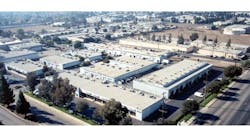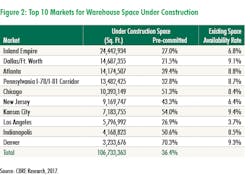The warehouse development pipeline hit a new high in the first quarter of this year, due to robust user demand and the need to modernize existing building inventory.
Almost half of the 167 million sq. ft. of U.S warehouse space currently under construction—72 million sq. ft.—is already pre-committed to tenants, primarily e-commerce, third-party logistics and retail users, according to a new report from CBRE Group, Inc.
The current tally of pre-committed warehouse space is the highest since 2000.
In addition, the current ratio of space under construction that is pre-leased to occupiers – 43% – exceeds the 17-year average of 38%. That signals healthy momentum for the market.
“Warehouse users are aggressively leasing space as soon as they have the opportunity, often even before the construction has been completed on the property," said David Egan, Americas head of industrial research, CBRE.
"This is unusual compared with historical activity. The high level of new deliveries will allow more occupiers to utilize modern space and will open up redevelopment opportunities for older product.”
When looking at the 10 U.S. markets with the largest amount of warehouse construction underway as of Q1 2017, 36% of space under construction is pre-committed.




